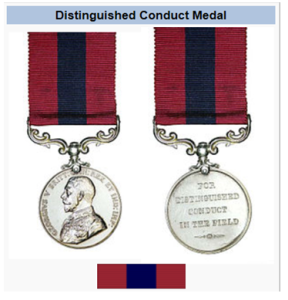Thursday, March 11, 1915
In Trenches, Rue Petillon
The Battalion War Diarist wrote for this day: “Fighting still going on at Neuve Chapelle. Stretcher-bearer Drake recommended for the Distinguished Conduct Medal. He went to the assistance of a man who was wounded in the open behind our front line. Drake was almost immediately severely wounded himself but remained with the man after he had bound up his wounds, being under continuous fire, until assistance came which enabled him to get the wounded man back to our lines. The recommendation was approved, and the medal awarded Drake, who was the first man in the 1st Canadian Division to obtain it.” [1]
THIS DAY IN RMR HISTORY: No. 25707, Private Drake, R.H., 14th Battalion Canadian Infantry: “For conspicuous gallantry and devotion to duty near Rue du Bois on 26th (sic)* March 1915, when he went out under heavy fire to the assistance of wounded comrades. He was immediately wounded himself, but nevertheless succeeded in dragging one man into safety and then rendered “first aid” to him.”
* Note the discrepancy between the date of the entry in the Bn. War Diary [March 11th], and the date mentioned in the citation quoted in the London Gazette [March 26th].
Reginald Harry Drake was born 30 Aug 1898 in Cambridge, England. He became a machinist by trade and emigrated to Montreal and served in the Canadian Grenadier Guards prior to enlisting for overseas service in September of 1914. After the War was over he returned to Canada with the 14th Battalion in April 1919 aboard the R.M.S. Carmania. On 19 October 1921, he married Emily Taylor in Toronto, and continued to reside in Toronto until his death there on 14 Oct 1936. He is buried in Prospect Cemetery, Toronto.
 “The Distinguished Conduct Medal (DCM) was (until 1993) an extremely high level award for bravery. It was a second level military decoration awarded to other ranks of the British Army and formerly also to non-commissioned personnel of other Commonwealth countries.
“The Distinguished Conduct Medal (DCM) was (until 1993) an extremely high level award for bravery. It was a second level military decoration awarded to other ranks of the British Army and formerly also to non-commissioned personnel of other Commonwealth countries.
The medal was instituted in 1854, during the Crimean War, to recognise gallantry within the other ranks, for which it was equivalent of the Distinguished Service Order (DSO) awarded for bravery to commissioned officers, but the DCM ranked well below the DSO in precedence.
From 1942, members of the Navy and Air Force were entitled to the award.
In the aftermath of the 1993 review of the honours system, as part of the drive to remove distinctions of rank in awards for bravery, the DCM was discontinued (along with the award of the DSO specifically for gallantry and of the Conspicuous Gallantry Medal). These three decorations were replaced by the Conspicuous Gallantry Cross, which now serves as the second level award for gallantry for all ranks across the whole armed forces.
 Bars were awarded to the DCM in recognition of the performance of further acts of gallantry meriting the award. Recipients are entitled to the post-nominal letters DCM.
Bars were awarded to the DCM in recognition of the performance of further acts of gallantry meriting the award. Recipients are entitled to the post-nominal letters DCM.
Description: A silver medal 36 mm in diameter. The original obverse of this medal depicted a trophy of arms as seen on early Army Long Service and Good Conduct Medals. However in 1902 this was replaced by the effigy of the reigning monarch.
- The reverse on all issues bears the inscription “FOR DISTINGUISHED CONDUCT IN THE FIELD”.
- The suspender is of an ornate scroll type.
- The ribbon is 32 mm wide, with three equal parts crimson, dark blue, and crimson.
Bars were authorised for subsequent awards originally bearing the date of the subsequent awards but changing to laurel wreaths in 1916.” [3]
[1] War Diary, 14th Canadian Battalion, The Royal Montreal Regiment, March 11, 1915. Library and Archives Canada, Ottawa, http://data2.collectionscanada.ca/e/e044/e001089701.jpg
[2] (The London Gazette, Supplement 29180, June 3, 1915, pg. 5341)
[3] Wikipedia contributors, "Distinguished Conduct Medal," Wikipedia, The Free Encyclopedia, http://en.wikipedia.org/w/index.php?title=Distinguished_Conduct_Medal&oldid=626479694 (accessed December 15, 2014).


